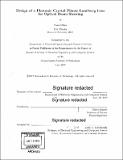Design of a photonic crystal planar Luneburg lens for optical beam steering
Author(s)
Kim, Samuel (Computer scientist) Massachusetts Institute of Technology.
Download1122564263-MIT.pdf (8.017Mb)
Other Contributors
Massachusetts Institute of Technology. Department of Electrical Engineering and Computer Science.
Advisor
Marin Soljačić.
Terms of use
Metadata
Show full item recordAbstract
Optical beam steering has numerous applications including light detection and ranging (LIDAR) for three-dimensional (3D) sensing, free space communications, additive manufacturing, and remote sensing. In particular, there is an increasing demand for LIDAR in a variety of applications including autonomous vehicles, unammaned aerial vehicles (UAVs), robotics, and remote sensing. Ideal solutions are small in size, weight, and power consumption (SWaP) while maintaining long range, high resolution, and large field of view (FOV). Here I present a design for a planar Luneburg lens for use in a silicon photonics optical beam steering device fabricated using CMOS-compatible techniques. The gradient index of the lens is achieved using a photonic crystal consisting of amorphous silicon patterned with a triangular lattice of holes layered on top of silicon nitride. Multiple waveguides can be placed along the focal circle of the lens and the lens is designed to collimate the beam from the waveguides. Through full-wave simulations, the lens is shown to be diffraction-limited with a beamwidth of 0.55° for a lens with radius R = 100 um. The lens is also studied for robustness to fabrication variations. The lens would allow a solid-state on-chip optical beam steering device with a FOV of 1600 with no off-axis aberrations.
Description
Thesis: S.M., Massachusetts Institute of Technology, Department of Electrical Engineering and Computer Science, 2019 Cataloged from PDF version of thesis. Includes bibliographical references (pages 55-60).
Date issued
2019Department
Massachusetts Institute of Technology. Department of Electrical Engineering and Computer SciencePublisher
Massachusetts Institute of Technology
Keywords
Electrical Engineering and Computer Science.